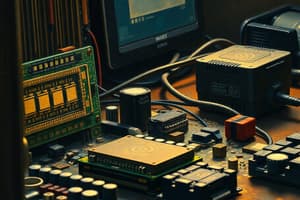Podcast
Questions and Answers
Which of the following is NOT considered an input device?
Which of the following is NOT considered an input device?
- Keyboard
- Touchpad
- Printer (correct)
- Joystick
Which component connects multiple computers and peripherals to enable data exchange?
Which component connects multiple computers and peripherals to enable data exchange?
- Networking components (correct)
- Power supply unit
- Storage device
- Output device
What is the primary function of a power supply unit (PSU) in a computer?
What is the primary function of a power supply unit (PSU) in a computer?
- To convert electricity from wall outlets into usable power levels for the computer's components (correct)
- To store data permanently
- To allow users to interact with the computer through input
- To display output produced by the computer
Which of the following is an example of an external storage device?
Which of the following is an example of an external storage device?
What is the purpose of a local area network (LAN)?
What is the purpose of a local area network (LAN)?
Which of these devices is considered an output device?
Which of these devices is considered an output device?
What is the primary function of the processor (CPU) in a computer?
What is the primary function of the processor (CPU) in a computer?
Which of the following is a characteristic of volatile memory?
Which of the following is a characteristic of volatile memory?
What is the purpose of nonvolatile memory in a computer?
What is the purpose of nonvolatile memory in a computer?
Which of the following is an example of a volatile memory type?
Which of the following is an example of a volatile memory type?
How can increasing the number of cores in a processor improve performance?
How can increasing the number of cores in a processor improve performance?
What determines the amount of memory needed in a computer system?
What determines the amount of memory needed in a computer system?
Flashcards are hidden until you start studying
Study Notes
Introduction
Computers are ubiquitous in today's world and have become essential tools for communication, entertainment, education, and business. They come in various forms, including desktops, laptops, tablets, smartphones, servers, and even embedded systems. At their core, computers consist of several interconnected components that work together to process information and perform tasks. In this article, we will explore the main computer components and their functions.
Processor
The processor, also known as the central processing unit (CPU), is the brain of the computer. It retrieves instructions from memory, decodes them, and performs calculations based on those instructions. Modern CPUs contain multiple cores, allowing them to execute multiple tasks simultaneously. Faster processors can improve overall system performance by reducing the time it takes to complete tasks.
Memory
Memory stores data temporarily while the CPU processes it. There are two primary types of memory: volatile and nonvolatile. Volatile memory, such as RAM, stores data only when power is applied. Once power is removed, the data is lost. Nonvolatile memory, like hard drives and solid-state drives (SSDs), store data even without power, making them suitable for permanent storage. The amount of memory used depends on the specific needs of the user or application.
Input Devices
Input devices allow users to interact with computers by providing input, such as keyboard strokes, mouse clicks, or touch screen gestures. Common input devices include keyboards, mice, touchpads, joysticks, microphones, webcams, scanners, and game controllers. Some modern computers support voice commands using built-in microphones and virtual assistants like Siri, Google Assistant, or Alexa.
Output Devices
Output devices display or produce results of computer processing. Examples include computer monitors, printers, speakers, headphones, and projectors. These devices enable users to see, hear, or print the output produced by the computer.
Storage
Storage devices hold data permanently so that it remains accessible after power is turned off. Hard disks and SSDs are common internal storage devices. External ones include USB flash drives and portable hard drives. Cloud storage services offer remote storage solutions.
Networking Components
Networking components connect multiple computers and peripherals to exchange data, enabling communication between devices. Local area networks (LANs) connect computers within a small geographic area, while wide area networks (WANs) link larger geographic areas. Wireless networking uses Wi-Fi technology, while wired connections may use Ethernet cables.
Power Supply Unit
A power supply unit converts electricity from wall outlets into manageable power levels for the computer's components. It ensures adequate voltage and current levels while protecting the components from electrical surges and spikes.
In conclusion, understanding these basic computer components helps you appreciate how they work together in your device. Each component plays a crucial role in ensuring efficient operation and reliable computing experience.
Studying That Suits You
Use AI to generate personalized quizzes and flashcards to suit your learning preferences.




